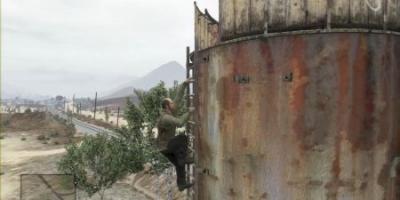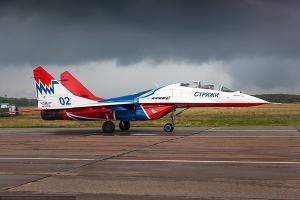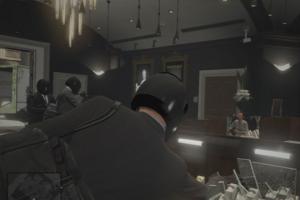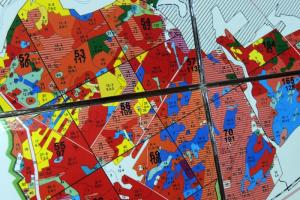TASS-DOSSIER /Valery Korneev/. May 6 marks the 25th anniversary of the first performance of the Swifts aerobatics team of the Air Force (Air Force, since August 1, 2015 - as part of the Aerospace Forces, VKS) of Russia.
"Swifts"- Russian aviation aerobatics team, formed in the early 1990s. from the pilots of the 237th Guards Proskurovsky mixed air regiment of the 16th Red Banner Air Army of the USSR Air Force (now the 237th Guards Proskurovsky Red Banner Order of Kutuzov and Alexander Nevsky. Aviation Equipment Display Center named after I.N. Kozhedub, 237th Guards TsPAT, Kubinka airbase, Moscow region).
Since 1967, the 237th Air Regiment specialized in aircraft demonstrations and aerobatics; in 1983, the regiment's pilots were the first in the USSR Air Force to begin mastering the MiG-29 light front-line fighter. The name "Swifts" was proposed by the pilots of the group, and later it was approved by the command.
Over the years, the group included more than 25 military pilots. Currently, the group (2nd aviation squadron of the 237th Guards TsPAT) uses six MiG-29 and MiG-29UB fighters (“combat training”, two-seat modification). Demonstration flight programs include group aerobatics in close formation of four or six aircraft, synchronized pair aerobatics, and single aerobatics.
History of the group's performances
The first demonstration flight of Swifts took place on May 6, 1991, this date is considered the group’s birthday. The first foreign performance took place in October of the same year during a friendly visit of a delegation of the Soviet Air Force to the location of the Upland air regiment of the Royal Swedish Air Force (Uppsala airbase).
Since 1991, Swifts have regularly participated in displays of aviation excellence at air shows in Russian cities and abroad - in France (1992, 2013), Malaysia (1993, 2015), Belgium (1993), Thailand (1993), China (1993) , 2004, 2008, 2012, 2013, 2014), Mongolia (1993), Hungary (1994), Germany (1994), Kazakhstan (1994, 2014), Sweden (1995), Finland (1997), USA (1997), Bulgaria (1997), the Netherlands (1997), the Czech Republic (2005), the UAE (2005, 2006, 2007, 2013), India (2013), Serbia (2014), etc.
Flights of the group's fighters in a diamond-shaped formation, both separately and as part of the "Cuban Diamond" (nine aircraft together with the Su-27 of the Russian Knights aerobatic team, which is also based in Kubinka), are a traditional element of the International Aviation and Space Salon program (MAKS, Zhukovsky, Moscow region), Victory Parade on Red Square in Moscow, International Naval Show in St. Petersburg.
"Swifts" participated in programs celebrating the 850th anniversary of Moscow (1997), the 290th anniversary of Yekaterinburg (2013), in the "Hydroaviation salons" in Gelendzhik, etc.
Accidents and incidents
During the history of the Swifts, one aviation incident occurred with the group’s aircraft. On July 27, 2006, when taking off from Perm Bolshoye Savino airport, a MiG-29UB (tail number “01 blue”) immediately after takeoff was unable to gain altitude, fell and caught fire. The crew of Nikolai Dyatl and Igor Kurylenko successfully ejected; one of the pilots received a lower leg injury. The accident occurred due to birds hitting both engines of the fighter.
Future change of aircraft
It is planned that during 2016, Swift pilots will switch from the MiG-29 to more modern aircraft. In January 2016, Colonel-General Viktor Bondarev, Commander-in-Chief of the Russian Aerospace Forces, told reporters that the decision on which Swift aircraft would be flown in 2017 would be made by the Russian Defense Minister. Earlier, in 2013, Russian Deputy Prime Minister Dmitry Rogozin stated that the aerobatic team would eventually master the MiG-35 aircraft.
Main composition of the air group
Sergey Osyaykin
Commander of the Swifts air group, lieutenant colonel
Group leader (solo, counter aerobatics)
In 1994 he graduated from the Kachinsky Higher Military Aviation School of Pilots, in 1997 – from the Air Force Engineering Academy named after N.E. Zhukovsky. During his service, he mastered the L-39, MiG-29, Yak-130 aircraft. The total flight time is 1700 hours. He has been flying aerobatics since 2000. 1st class military pilot.
Dmitry Zubkov
Left wingman, major
In 2003 he graduated from the Krasnodar Military Aviation Institute. During his service, he mastered the L-39, MiG-29, MiG-29S, and Yak-130 aircraft. The total flight time on these types of aircraft is 1400 hours. Military pilot 1st class.
Dmitry Ryzhevolov
Right wingman, major
In 2003 he graduated from the Krasnodar Military Aviation Institute. During his service, he mastered the L-39, MiG-29, Yak-130 aircraft. The total flight time on these types of aircraft is 1100 hours. Military pilot 1st class.
Denis Kuznetsov
Tail wingman, major
Graduate of the Ussuri SVU in 1997. In 2002 he graduated from the Krasnodar Military Aviation Institute. During his service, he mastered the L-39, MiG-29, MiG-29SMT, Yak-130 aircraft. The total flight time is 1200 hours. He has been flying aerobatics since 2007. 1st class military pilot.
Vasily Dudnikov
Left wingman, major
In 2003 he graduated from the Krasnodar Military Aviation Institute. During his service, he mastered the L-39, MiG-29, MiG-29SMT aircraft. The total flight time on these types of aircraft is 1000 hours. Military pilot 1st class.
Sergei Sinkevich
Right wingman, major
In 2004 he graduated from the Krasnodar Military Aviation Institute. During his service, he mastered the L-39, Tu-134, MiG-29 aircraft. The total flight time on these types of aircraft is 1350 hours. Military pilot 1st class.
"Video provided by the Voeninform Agency of the Russian Defense Ministry"
“Swifts” is an aerobatic aviation team (AGVT) of the Russian Air Force created on the basis of the 234th Guards Proskurovsky Fighter Aviation Regiment. The official birthday of the group is May 6, 1991, when it first performed at an aviation show called “Swifts” on supersonic jet front-line fighters MiG-29. The Swifts are located at the Russian Air Force base Kubinka in the Odintsovo district of the Moscow region.
The main composition of the AGVP "Swifts" aerobatic team in 2017:
- Presenter - Lieutenant Colonel Sergei Osyaikin
- Left Slave - Major Dmitry Zubkov
- Right wingman - Major Dmitry Ryzhevolov
- Tail slave - Major Denis Kuznetsov
- Left extreme slave - Major Vasily Dudnikov
- Right extreme slave - Major Sergei Sinkevich
“Russian Knights” is the only aviation group in the world that demonstrated aerobatic maneuvers on heavy Su-27 combat fighters. The Russian Knights group was formed on April 5, 1991 from pilots of the 1st squadron of the 237th Guards Proskurovsky mixed air regiment. Like the Swifts, they are based at the Kubinka airbase near Moscow. The first performance of the Knights took place four and a half months after the official birthday of the group, on August 24, 1991, at the first Polish air show in Poznan. Since 2016, Vityaz has been flown on two-seat multi-role heavy fighters Su-30SM.
The main composition of the AGVP "Russian Knights" aerobatic team in 2017:
- No. 1 - commander of the air group, guard Colonel Andrei Alekseev
- No. 2 - guard captain Vladimir Kochetov
- No. 3 - Guard Lieutenant Colonel Alexander Bogdan
- No. 4 - Guard Lieutenant Colonel Sergei Shcheglov
- No. 5 - Guard Lieutenant Colonel Oleg Erofeev
Why are “Swifts” and “Russian Knights” needed?
Russian aerobatic teams were created with the goal of attracting young people to aviation, but most importantly, to demonstrate the capabilities of the Air Force’s advanced aviation technology and interact with pilots from other countries.
AGVP pilots have the class qualification of “1st class pilots” and a total flight time of over 1000 hours. The Swifts and Vityaz aircraft do not differ from combat vehicles in anything except their coloring (the color of the Russian tricolor). Airplanes do not take part in hostilities.
Joint flights of Swifts and Russian Knights
On March 15, 2003, a public joint aerobatics of Swifts and Russian Knights took place. One of the most recognizable aerobatic figures was a giant diamond consisting of four MiG-29s and five Su-27s. This aerobatic formation was named "Cuban Diamond".
In 2004, the complex of shows included a joint flight of aerobatic teams consisting of nine aircraft (five Su-27s and four MiG-29s) in a diamond formation, performing a full range of aerobatic maneuvers. This fact became a world record in the history of aviation. For several years in a row, Swifts and Vityazis have been flying in formation over Red Square on May 9 and representing Russia at international air shows.
Performance characteristics of the MiG-29 fighter
- Length - 17.32 m
- Wingspan - 11.36 m
- Height - 4.73 m
- Normal take-off weight - 15,300 kg
- Maximum flight speed - 2450 km/h at altitude, 1500 km/h at the ground
- Armament - medium-range missiles - 2 x R-27(T), close-in missiles - 6 x R-73, cannon - GSh-301 (30/150)
Performance characteristics of the Su-30SM fighter
- Length - 21.9 m
- Wingspan - 14.7 m
- Height - 6.36 m
- Normal take-off weight - 24900 kg
- Maximum flight speed is 2125 km/h at altitude, 1350 km/h at the ground.
- Armament - 30-mm built-in cannon GSh-30-1, 6 medium-range guided missiles and 6 close-range missiles, free-fall bombs weighing 500 kg (up to 8 units) or 250 kg (28 units).
Incidents
On December 12, 1995, while landing 25 kilometers from the Cam Ranh airbase located in Vietnam, three Su-27 Russian Knights aircraft collided with a mountainside covered by clouds. The pilots were returning from the Lima-95 international air show. As a result of the collision, the planes were completely destroyed, four members of the aerobatic team - Lieutenant Colonel Boris Grigoriev, Majors Alexander Syrov, Nikolai Kordyukov, and Nikolai Grechanov- died. After the tragedy, the Russian Knights squadron did not take to the air for almost a year. Since 1996, Vityazi resumed flights.
In 2006, a MiG-29UB aircraft of the Swifts aerobatic team crashed immediately after takeoff from Perm Bolshoye Savino airport. Crew included Nikolai Dyatl and Igor Kurylenko successfully ejected. The cause of the accident was birds getting into both engines. There were no casualties or destruction at the site of the plane crash.
"Swifts"- aviation aerobatics team of the Russian Air Force. It was formed on May 6, 1991 on the basis of the 234th Guards Proskurovsky Air Regiment from the best pilots of the Kubinka airbase near Moscow. It is part of the I. N. Kozhedub Aviation Equipment Display Center. Performs group and single aerobatics on multi-role highly maneuverable MiG-29 fighters.
| Swifts | |
|---|---|
| MiG-29UB aerobatic team "Swifts" |
|
| basic information | |
| Full title | Aerobatic team "Swifts" 237th Russian Air Force Aviation Equipment Display Center named after. I. N. Kozhedub |
| Years of existence | May 6, 1991 - present |
| A country |
USSR → |
| Type of army | Russian Air Force |
| Location |
Kubinka (air base) Moscow region |
| Colors |
White blue red |
| Marks of Excellence | |
| Emblem | |
| Aircraft | |
| Fighters | 6 - MiG-29 |
| Official website of AGVP "Strizhi" | |
| Media files on Wikimedia Commons | |
The Swifts are based at the Kubinka airfield located 60 kilometers from Moscow. Kubinka pilots were the first in the USSR to master single and group aerobatics on jet fighters: on May 1, 1946, they flew over Moscow for the first time in the parade formation. Today Kubinka is known as the number 1 school of aerobatic skills in Russia. At the beginning of May 2011, the Swifts aerobatic team celebrated its 20th anniversary with a new flight program. Five years later, on May 21, 2016, the Swifts aerobatic team celebrated its quarter-century anniversary, which they celebrated together with the Russian Knights.
History of the group
The Swifts aerobatic team is part of the 234th Guards Proskurovsky Fighter Aviation Regiment of the 16th Air Army. It traces its history back to 1950, when the formation of the new 234th Fighter Aviation Regiment began. The backbone of the flight crew was the aerobatic pilots. The main task of the regiment was to prepare and conduct traditional air parades over Moscow, the first of which took place on May 1, 1951.
In 1983, the 234th Guards Fighter Aviation Regiment was the first in the Soviet Air Force to begin developing the MiG-29 fighter. In 1986, a group of six MiG-29s visited the Finnish Rissala airbase, during which Soviet fourth-generation fighters were shown abroad for the first time. In 1990, the squadron pilots flying the MiG-29 were tasked with mastering aerobatics in a tight formation consisting of six aircraft. The pilots flew at intervals and at a distance of about 3 meters, performing a complex set of maneuvers.
Start of flights
In 1988, two MiG-29 aircraft attended the Farnborough Air Show, and a year later they were demonstrated in Le Bourget. Preparing for their international debut, the pilots thought about the image side of their activities. For the MiG-29 and MiG-29UB aircraft, they came up with an original coloring - white fuselages and bright blue fins, blue lightning bolts running along the sides, and the group's emblems - black swifts on a red background - appeared on the air intakes under the bulges. These nimble birds gave the name to the group - the group went down in history under the name “Swifts”.
The official birthday of the aviation aerobatics team is May 6, 1991. On that day, the Swifts made their debut in the air on aircraft with the original coloring and a new name. The first commander of the AGVP Strizhi was Guard Major Alexander Mikhailovich Dyatlov.
1990s
In May 1991, the Swifts visited Sweden. The flights could only be observed by colleagues and a few representatives of the media, since the broad masses of the Swedish people did not receive access to the Uppsala airbase. The Swifts appeared in public in May 1992, when the group was invited to take part in a grand air celebration at the Reims airbase, held in honor of the 50th anniversary of the famous Normandy-Niemen regiment. Over two years, the group gave 50 performances at air festivals and official shows in Kubinka and various cities of Russia.
In 1993, the group took part in the MAKS-93 air show, and in the fall of the same year they visited Belgium and Thailand. In December, Swifts were invited to participate in the LIMA-93 air show. The planes were delivered to Malaysia disassembled by military transport aircraft. Then the aviation aerobatic team "Swifts" was awarded the title "Best Aerobatic Team in the World."
In 1994, Swifts took part in an air festival at Sprenger airfield in Germany. In May 1995, the squadron served as escort for the leader's Tu-160 aircraft over Poklonnaya Gora during a grand air parade in honor of the 50th anniversary of Victory in the Great Patriotic War. In August of the same year they took part in the MAKS-95 air show.
In 1996, they took part in the Gelendzhik-95 hydroair show, and also traveled abroad, taking part in an air show at the Finnish base of Oulu. 1997 was marked by a rich program of performances at an air show in the Bulgarian city of Varna, a visit to Holland as part of the Russian military delegation, a performance at MAKS-97, as well as a performance over Tushino at an air festival in honor of the 850th anniversary of Moscow. At the international air show in Finland in 1997, group commander Nikolai Dyatel took first place in solo aerobatics.
In 1998, the group performed at the hydroair show in Gelendzhik and visited Orenburg and Yekaterinburg. She took part in the “Combat Commonwealth-98” exercise at the Ashuluk training ground near Astrakhan. In 1999 she performed at MAKS-99.
2000s
The year 2001, which opened the new millennium, became something of a milestone for the Swifts. The ranks of the group were replenished with new pilots. Guard Lieutenant Colonel Vadim Shmigelsky began practicing the solo aerobatics program, and in October 2001, at a festival in Astrakhan, he performed his first show. Guard Lieutenant Colonel Mikhail Loginov, Guard Majors Valery Morozov, Igor Sokolov, Sergei Osyaikin, Dmitry Koposov, and Guard Captain Alexey Prokhorov began to master group aerobatics. Winter and spring were spent in intense training, and in September 2002 the group performed brilliantly over the sea bay in Gelendzhik during the next hydroair show.
In subsequent years, the group actively participated in air shows in Russia and abroad. In 2007, seven MiG-29 aircraft, taking off from the runway of the Kubinka airbase, headed for Astrakhan - an intermediate point of the route - with the final destination being Al Ain airfield in the United Arab Emirates. "Swifts" took part in all shows at the MAKS air show. On May 9, 2010, the group flew over Red Square together with the “Russian Knights” during the aerial part of the Victory Parade.
At the beginning of June 2011, information appeared that the aerobatic team would be disbanded.
At the beginning of May 2012, the group, together with the Russian Knights, was supposed to take part in the KADEX-2012 exhibition in Astana. The visit, however, was disrupted for unknown reasons, despite existing international agreements and lengthy preparations. On the planned days, the pilots flew through Engels to Chelyabinsk, but did not receive permission to cross the border and fly to Kazakhstan from the Russian government. On May 5, the group returned to Kubinka.
On June 2, 2012, “Swifts” as part of a diamond formation in difficult weather conditions were shown at the celebration of the 70th anniversary of the 1st Leningrad Red Banner Air Force and Air Defense Command over the Pushkin airfield in the Leningrad region.
The group is scheduled to participate in the celebration of the 100th anniversary of the Russian Air Force in August 2012.
The group took part in the celebration of the 100th anniversary of the Serbian Air Force in September 2012.
In August 2018, as part of the Army-2018 military-technical forum, Swifts demonstrated a new formation: the “star”.
On November 3, 2018, the Swifts aerobatics team held demonstration performances in Krasnodar as part of the celebration of the 80th anniversary of the Krasnodar Higher Military Aviation School
Joint flights with Russian Knights
In addition, the pilot from the AGVP "Swifts" Sergei Osyaykin and the pilot of "Russian Knights" Alexander Bogdan, in addition to performing in their aerobatic teams, jointly perform paired aerobatics on the Su-57 (PAK FA).
Performance program
The group has a large repertoire of aerobatics performed by a group and a couple of aircraft, as well as solo performances. The performance complex includes such aerobatic formations as “pyramid”, “hammer”, “star”, “arrow”, “cross” and “wing”. At the MAKS-2007 air show, a group of 9 aircraft (4 MiG-29 Swifts and 5 Su-27 Russian Knights) performed a “barrel roll” in the “Big Diamond” aerobatic formation (“big diamond”, “mixed diamond”). This (in a mixed formation of different types of aircraft) has never been achieved by any aerobatic team in the history of world aviation. Not long ago, the group introduced a new element of the program, when six Swifts perform a loop with the landing gear extended and the headlights on. The dynamic group and individual aerobatics of the group's pilots were highly appreciated in many countries around the world.
One of the most famous aerobatic teams in our country is Swifts. And many of us have seen their flights with our own eyes, because they very often conduct various demonstration flights. And today we will briefly tell you about them.
The history of the creation of the Swifts aerobatic team
Swifts were born back in 1991 at the 237th base of the Russian Guards Air Regiment, named after Proskurovsky. This aerobatic team included the best and bravest pilots from one little-known airbase called Kubinka, located near Moscow. They fly famous aircraft such as the MiG-29.
The main task of this aerobatic team was and remains the preparation and conduct of air parades. And, to be honest, they perform their task simply to the highest class. It was not for nothing that some of the best pilots were recruited into this group. Which, by the way, remain one of the best pilots in the world today.
Almost at the beginning of the aerobatic team’s existence, it was assigned as an escort to the planes of famous politicians and serious foreign diplomats. In addition to them, the pilots were engaged in escorting aircraft that carried the first Soviet cosmonauts. In general, Swifts had a fairly long track record, which only expanded over the years. As a result, they are very popular today.

Today, the Strizhi aerobatic team is proudly part of one of the largest centers specializing in displaying various aviation equipment. Over the years they have honed their flying experience and today they can easily perform single and even group aerobatics of any complexity. And not all pilots can do this.
It is worth noting that the pilots who served at base 237 were the first to begin mastering the then newest MiG-29 aircraft. This was in 1983. And only 7 years later, in 1990, they began performing the most complex aerobatic complexes. In particular, it was they who began to master all the features of aerobatics from 6 aircraft, while in close formation. The distance between them did not exceed three meters, while they performed simply unimaginable complexes of figures.
Start of flights of the Swift group
Since 1988, two MiG-29 aircraft have visited air shows of various countries, conducting their demonstrations. At the same time, when the question of the world fame of the pilots arose, they began to worry about creating a specific, bright and no less memorable image.
It was during that period that they came up with the color that we can see today. The pilots used white fuselages as a basis. Blue lightning bolts were placed along the sides of the aircraft, and black swifts on a red background appeared on the air intakes under the swells. It is on this basis that the aerobatic team got its name. The official birthday of the group is May 6, 1991, when the pilots performed in their full livery, showing truly aerobatics.

Over the next two years of flights, the aerobatic team gave more than 50 different performances. They included both our Russian holidays and events, and foreign ones. A little later, the guys took part in the famous MAKS-93 air show. After which they went to Malaysia, where they were awarded an honorary award as the best aerobatic team in the world.
Joint flights of Swifts with Russian Knights
Quite an important stage in the career of the Swifts were and are their flights with another aerobatic team - the Russian Knights. The first flights with a joint crew were made before the beginning of the twentieth century. However, since 2002, both aerobatic teams have gained extensive experience in joint flights. And now they are simply performing with first-class programs, amazing everyone with their skills.

And today, they perform in large numbers with common programs, in which up to a dozen different aircraft simultaneously take part. And if you haven’t seen their performances yet, I definitely recommend attending their joint flight. You will definitely get a lot of good impressions.
Performance program of the group Swifts
One of the main reasons why Swifts are so loved is that they rarely repeat their tricks. Their repertoire is very large, both in single flights and in group flights. Moreover, due to various combinations of aerobatic formations and a wide variety of performance techniques, they win the hearts of Russian citizens. And not only them. And they usually perform the following aerobatic procedures:
- Pyramid.
- Hammer.
- Star.
- Arrow.
- Cross.
- Wing.
One of the most famous cases occurred at the MAKS-2007 air show, when Swifts, together with the Russian Knights, a group of 9 different aircraft, performed such an element of the air program as a barrel roll, and they did it in an aerobatic formation called a large diamond. Simple words simply cannot describe this spectacle.
It is worth noting that no other aerobatic team in the world has been able to repeat this. So we can safely be proud of our Russian pilots. After all, this is one of the few things that we were the first to do, and, so far, the only ones.
The Swifts aerobatic team has recently been delighting all its viewers with new elements of its program. In particular, a group of six aircraft performs a loop, and they do it not just like that, but with their landing gear down and their headlights on. Everyone who has already seen such a spectacle praises our guys.
And it’s worth saying that the skill of our pilots did not go unnoticed abroad. They receive high aerobatics ratings in many countries around the world. Which, of course, is well deserved.

Aerobatic team accidents
But, despite all the professionalism of these pilots, it was still not possible to completely avoid the accident. In all 24 years of the aerobatic team’s existence, only two accidents were recorded. Fortunately, in both of them not a single pilot from the crew was injured.
The first happened in 2006 - the plane of the Russian aerobatic team fell to the ground almost immediately after takeoff. The entire crew successfully ejected, which subsequently saved their lives. According to available data, the plane was refueling at the airport where the crash occurred. However, almost immediately after takeoff, birds accidentally flew into two engines, which caused a terrible accident.
The second incident occurred a little later - in 2009. During a joint flight with a well-known aerobatic team called the Russian Knights, two SU-27 aircraft belonging to the friendly group crashed. However, neither the planes nor the pilots of the Swifts aerobatic team were seen among the victims.
In the entire history of the aerobatic team’s existence, no more serious incidents have occurred. Russian pilots definitely know their job and perform it to the highest standard. For which they constantly receive well-deserved awards.
If you have any questions, leave them in the comments below the article. We or our visitors will be happy to answer them
« Swiftś - aerobatics team of the Russian Air Force. It was formed on May 6, 1991 on the basis of the 237th Guards Proskurovsky Air Regiment from the best pilots of the Kubinka airbase near Moscow. It is part of the I. N. Kozhedub Aviation Equipment Display Center. Performs group and single aerobatics on multi-role highly maneuverable MiG-29 fighters.
The Swifts are based at the Kubinka airfield, located 60 kilometers from Moscow. Kubinka pilots were the first in the USSR to master single and group aerobatics on jet fighters: on May 1, 1946, they flew over Moscow for the first time in the parade formation. Today Kubinka is known as the number 1 school of aerobatic skills in Russia. At the beginning of May 2011, the Swifts aerobatic team celebrated its 20th anniversary with a new flight program. 
History of the group
The Swifts aerobatic team is part of the 234th Guards Proskurovsky Fighter Aviation Regiment. It traces its history back to 1950, when the formation of the new 234th Fighter Aviation Regiment began. The backbone of the flight crew was the aerobatic pilots. The main task of the regiment was to prepare and conduct traditional air parades over Moscow, the first of which took place on May 1, 1951.
Since the mid-1950s, ground and flight demonstrations of military aviation equipment began to be held in Kubinka for students of military academies, the leadership of the Ministry of Defense and the General Staff, leaders of the Soviet state and the Communist Party, delegates of CPSU congresses, as well as state and military delegations of foreign countries. Since the early 1960s, pilots of the 234th “aerobatic” regiment, in addition to combat training, participation in air parades and displays of aviation equipment, began to regularly escort in the air the planes of heads and leaders of foreign states arriving in Moscow. In addition to the planes of official delegations, the regiment's pilots also escorted planes carrying the first Soviet cosmonauts.
On July 9, 1961, on the Day of the USSR Air Fleet, a grandiose air parade was held in Tushino, in which the pilots of the 234th regiment took an active part.
In 1983, the 234th Guards Fighter Aviation Regiment was the first in the Soviet Air Force to begin mastering the MiG-29 fighter. In 1986, a group of six MiG-29s visited the Finnish Rissala airbase, during which Soviet fourth-generation fighters were shown abroad for the first time. In 1990, the squadron pilots flying the MiG-29 were tasked with mastering aerobatics in a tight formation consisting of six aircraft. The pilots flew at intervals and at a distance of about 3 meters, performing a complex set of maneuvers.
Start of flights
In 1988, two MiG-29 aircraft visited the Farnborough air show, and a year later they were demonstrated in Le Bourget. Preparing for their international debut, the pilots thought about the image side of their activities. For the MiG-29 and MiG-29UB aircraft, they came up with an original coloring - white fuselages and bright blue fins, blue lightning bolts running along the sides, and the group's emblems - black swifts on a red background - appeared on the air intakes under the bulges. These nimble birds gave the name to the group - the group went down in history under the name “Swifts”.
The official birthday of the aviation aerobatics team is May 6, 1991. On that day, the Swifts made their debut in the air on aircraft with the original livery and a new name.
1990s
In May 1991, the Swifts visited Sweden. The flights could only be observed by colleagues and a few media representatives, since the broad masses of the Swedish people did not receive access to the Uppsala airbase. The Swifts appeared in public in May 1992, when the group was invited to take part in a grand air celebration at the Reims airbase, held in honor of the 50th anniversary of the famous Normandie-Niemen regiment. Over two years, the group gave 50 performances at air festivals and official shows in Kubinka and various cities of Russia. In 1993, the group took part in the MAKS-93 air show, and in the fall of the same year visited Belgium and Thailand. In December, Swifts were invited to participate in the LIMA-93 air show. The planes were delivered to Malaysia disassembled by military transport aircraft. Then the aviation aerobatic team "Swifts" was awarded the title "Best Aerobatic Team in the World."
In 1994, Swifts took part in an air festival at Sprenger airfield in Germany. In May 1995, the squadron served as escort for the leader's Tu-160 aircraft over Poklonnaya Gora during a grand air parade in honor of the 50th anniversary of Victory in the Great Patriotic War. In August of the same year they took part in the MAKS-95 air show.
In 1996, they took part in the Gelendzhik-95 hydroair show, and also traveled abroad, taking part in an air show at the Finnish base of Oulu. 1997 was marked by a rich program of performances at an air show in the Bulgarian city of Varna, a visit to Holland as part of the Russian military delegation, a performance at MAKS-97, as well as a performance over Tushino at an air festival in honor of the 850th anniversary of Moscow. At the international air show in Finland in 1997, group commander Nikolai Dyatel took first place in solo aerobatics.
In 1998, the group performed at the hydroair show in Gelendzhik and visited Orenburg and Yekaterinburg. She took part in the “Combat Commonwealth-98” exercise at the Ashuluk training ground near Astrakhan. In 1999 she performed at MAKS-99.
2000s
The year 2001, which opened the new millennium, became something of a milestone for Swifts. The ranks of the group were replenished with new pilots. Guard Lieutenant Colonel Vadim Shmigelsky began practicing the solo aerobatics program, and in October 2001, at a festival in Astrakhan, he performed his first show. Guard Majors Valery Morozov, Igor Sokolov, Sergei Osyaikin, Dmitry Koposov, and Guard Captain Alexey Prokhorov began to master group aerobatics. Winter and spring were spent in intense training, and in September 2002 the group performed brilliantly over the sea bay in Gelendzhik during the next hydroair show.
In the winter of 2003, the MiG-29 aircraft underwent scheduled repairs and acquired a new paint scheme. The MiGs were repainted in a new red and white uniform with a bright blue silhouette of a swift on top and bottom, and the letters “MiG” on the fins. For the first time in a new guise they were shown to the public on March 15, 2003 during the celebration of the 65th anniversary of the regiment. From this moment on, active cooperation with the Russian Knights aerobatic team begins. This year, a huge amount of work was carried out at the Kubinka airbase to replace the surface and equipment of the runway, during which aerobatic teams flew to the airbase in Andreapol.
In subsequent years, the group actively participated in air shows in Russia and abroad. In 2007, seven MiG-29 aircraft, taking off from the runway of the Kubinka airbase, headed for Astrakhan - an intermediate point on the route - with the final destination being Al Ain airfield in the United Arab Emirates. "Swifts" took part in all shows at the MAKS air show. On May 9, 2010, the group flew over Red Square together with the Russian Knights during the aerial part of the Victory Parade.
Joint flights with Russian Knights
“Swifts” and “Russian Knights” have been conducting joint flights since the end of the 20th century, such training has been continued since the fall of 2002 in different aerobatic formations with eight, nine and ten aircraft, and, having accumulated a lot of experience, are currently performing a large joint program .
On March 15, 2003, during the celebration of the 65th anniversary of the regiment, the first public joint aerobatics of the Swifts and the Russian Knights took place; on June 12, they flew in one formation over Red Square in honor of Russian Independence Day, and in August, pilots of the two groups performed at the air show MAKS-2003 in Zhukovsky.
At the opening of the new International Festival of Aerobatic Teams in Zhukovsky in August 2004, “Swifts” and “Russian Knights” for the first time in the general public, in the presence of numerous foreign delegations, presented their new “big diamond” program of nine aircraft, including aerobatic maneuvers in joint building the MiG-29 and Su-27, and the work of the groups after the disbandment.
Performance program
The group has a large repertoire of aerobatics performed by a group and a couple of aircraft, as well as solo performances. The performance complex includes such aerobatic formations as “pyramid”, “hammer”, “star”, “arrow”, “cross” and “wing”. At the MAKS-2007 air show, a group of 9 aircraft (4 MiG-29 “Swifts” and 5 Su-27 “Russian Knights”) performed a “barrel roll” in the “Big Diamond” aerobatic formation (“big diamond”, “mixed diamond”). This (in a mixed formation of different types of aircraft) has never been achieved by any aerobatic team in the history of world aviation. Not long ago, the group introduced a new element of the program, when six Swifts perform a loop with the landing gear extended and the headlights on. The dynamic group and individual aerobatics of the group's pilots were highly appreciated in many countries around the world.
Accidents
In 2006, a MiG-29UB aircraft of the Swifts aerobatic team crashed immediately after takeoff from Perm Bolshoye Savino airport. The crew of Nikolai Dyatl and Igor Kurylenko successfully ejected. The Swifts aerobatic team was heading from Kubinka to Tyumen to perform demonstration flights. Scheduled refueling was carried out at Bolshoye Savino airport. The cause of the accident was birds getting into both engines. There were no casualties or destruction at the site of the plane crash.
In 2009, during a joint flight with the Russian Knights aerobatic team, two fighters crashed








